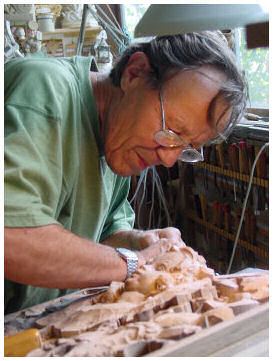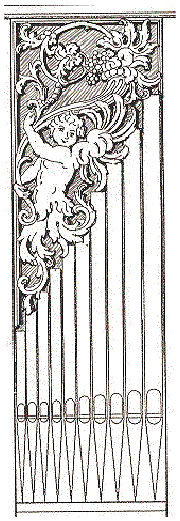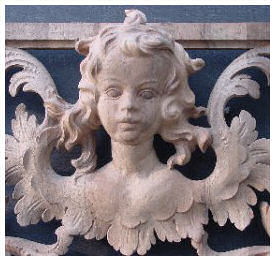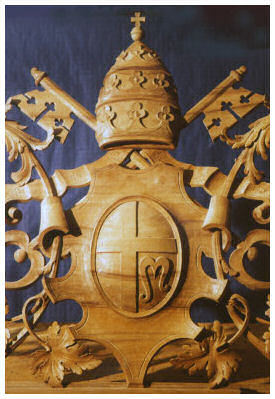
Interview mit Josef Schibig:
Für mich selber wie auch für Freunde und Bekannte unerwartet, wurde meine bescheidene Werkstatt im Herbst 2000 mit dem sehr anspruchsvollen Auftrag beehrt, für eine neue grosse Orgel in der Sixtinischen Kapelle die Ornamente zu entwerfen und zu schnitzen.
Mit Fragen überhäuft, versuche ich hier, die wichtigsten davon kurz anzutippen - endgültige Antworten wären wohl erst dann möglich, wenn die Arbeit vollendet ist. (was unterdessen, mit der feierlichen Einweihung am 14. Dezember 2002, geschehen ist.)
Vorerst bin ich vor allem dankbar, wenn Sie die Vorschusslorbeeren noch eine Weile unter Verschluss halten . . .
Very surprising for me and for my friends, my modest workshop was honoured in the autumn of 2000 with the very demanding commission of designing and sculpting ornaments for a large new pipe-organ in the Sistine Chapel. Overwhelmed with questions, I am trying to answer some of them. Final judgement should be reserved for the year 2002 when the organ is expected to be finished. (In the meantime this was acomplished with the inauguration 14. december 2002 in Rome.)

Wie kommt die Bildhauerei Schibig zu diesem Auftrag?
Nun, eigentlich ohne mein grosses Dazutun: Es sei denn, man wolle eine lebenslange bewusste Anstrengung, stets den Möglichkeiten entsprechend das Allerbeste zu leisten, anrechnen. Damit habe ich, katholisch erzogen (dazu noch eine spätere Frage), schon in den Kindertagen begonnen: wir sind nicht dazu da, dem Herrgott den Tag abzustehlen. Bei der Berufsausbildung schieden sich früher die Holzbildhauer in die mehrbesseren Figuristen und die minderen Ornamenter. Nolens volens — es waren in meiner Zeit kaum genügend Aufträge vorhanden, um sich in dieser Art zu kaprizieren — habe ich mich stets intensiv mit beidem befasst. Heute ist es nun so weit, dass anständige Ornamentisten eine rare aussterbende Spezies geworden sind.
Im Detail lief es dann so: seit Jahrzehnten durfte ich - wie auch mit andern renommierten Orgelbauern - zusammen mit bereits zwei Generationen der Firma ORGELBAU MATHIS in Näfels manche schöne Kirchenorgel gestalten (über 130 in ganz Europa).
Der Vatikan wurde von einer vermöglichen Stiftung angegangen, dass man bereit wäre, ein grosses repräsentatives Geschenk zu machen. Bald ging die Sache in Richtung einer grossen Orgel für die Sixtinische Kapelle. Die Orgel muss transportabel sein, weil sie nur für besondere Anlässe in der Kapelle aufgestellt werden darf, zwischenhinein wird sie hin ausgeschafft und anderswo gelagert.
How did Schibig Sculptor get this order?
This contract was awarded with little in the way of a submission from the company. We believe this constitutes recognition of desire to give of our best, even when the resources were limited. The founders catholic upbringing assured good working ethics. He recalls that at the time of his apprenticeship, which commenced in 1945, there were considered to be two classes of wood-carvers, the „better“ carving statues and the „lesser“ ornaments. He found it necessary to study and practise both because there were insufficient commissions to survive confining himself to one. Today, ornamental carvers still do not receive the same recognition, but good ones are becoming increasingly rare. As a result of Schibig‘s willingness to undertake such work, the company has built an enviable reputation by involvement in more than 130 organ buildings and restorations in Europe and beyond. The firm has worked with two generations at ORGELBAU MATHIS and many others. A major Foundation offered a substantial donation to the Vatican which finally resulted in a decision to commission a grand organ for the Sistine Chapel. The organ will be transportable and will be stored away from the Chapel when not in use.
Ein zusätzlicher Haken war dabei: vor wenigen Jahren war dorthin bereits eine Pfeifenorgel aus dem fernen Brasilien geschenkt worden. Dieser ist aber anscheinend das Klima und die dafür gewählte Konstruktion (in drei einzelnen tragbaren Gehäuseteilen) nicht gut bekommen, sie ist nicht mehr spielbar. Firma Mathis hatte bereits früher zwei Kirchenorgeln für den Vatikan geliefert, und der oberste Organist dort stellte fest, dass von allen Orgeln des Vatikanstaates nur gerade diese zwei durchwegs tadellos funktionieren. Damit war die Frage nach dem Lieferanten natürlich bereits geregelt . . .
Als Herr Mathis mir im Jahr 2000 telefonierte und sagte, ich müsse ihm stante pede Entwürfe für Ornamente zu einer Nussbaum-Orgel in die Sixtinische Kapelle zeichnen, dachte ich zuerst doch eher an einen Scherz. Aber nein, es war sein Ernst! Ich lieferte die Zeichnungen samt Offerte innert wenigen Tagen ab, darauf folgte eine eher nervenzehrende Zeit des Hangens und Bangens; doch noch im gleichen Herbst kam nach dem üblichen Hinundher die Bestätigung, dass der Auftrag perfekt sei! Mein Auftraggeber ist also nicht etwa der Vatikan, sondern die weltweit renommierte Firma Mathis.
Die Mathis-Orgel ist ca. dreieinhalb Meter breit und samt Aufsatz etwa vier Meter hoch. Sie steht auf einem fahrbaren Podest ähnlich jenem, das in Cape Canaveral für den Transport der Raumflugkörper verwendet wird. Zwischen den "Auftritten" wird sie in einem speziellen Raum aufgestellt, der genau gleich klimatisiert ist wie die Kapelle selbst. Die Masse mussten der vorhandenen Tor-Öffnung angepasst werden. Der Aufsatz wird für das Verschieben umgelegt. Unsere Ornamente werden im Renaissance-Stil geschnitzt.

A major factor in the selection was in the task: that some years ago a pipe-organ had been given to the Chapel, from Brazil. It transpired that the climate and the chosen method of construction (in three separate portable sections) was unsuitable. The organ can no longer be played. Years before Mathis Company had executed two organs for the Vatican. The chief organist of the State noted that of the numerous organs in his custody only two functioned faultlessly.
When Mr Mathis phoned me in 1999 and said, I should immediately set about designing ornaments for an organ in the Sistine Chapel, I thought it was a joke. But no, he was in earnest! So I designed the ornaments and calculated the price in some few days. After some rather nerve-consuming weeks and after the usual “back and forth” the confirmation finally arrived that the order was awarded. My customer is the worldwide renowned Mathis Company, not the Vatican itself.
The organ will measure about four meters in length and height. It is mounted on a rolling platform, similarly to the one used in Cape Canaveral for transporting rockets. Between “performances” in the Chapel the organ will be stored in a specially built, air-conditioned room adjacent to the Chapel. The organ has to fit the existing portal; the head-piece has to be hinged to provide the necessary clearance.
Our ornaments will be carved in walnut, renaissance-style.
"Die Sixtinische Kapelle (nach: Hinzen-Bohlen ROM, Könemann Köln)
Der berühmteste Raum der Musei Vaticani, die Capella Sistina, wurde von Giovanni de‘Dolci 1475—81 im Auftrag Sixtus‘ IV. erbaut. Der monumentale Raum misst 40,5 mal 13,2 m und ist 20,7 m hoch. Andrea Bregno schuf die Marmorschranke und die berühmte Sängerkanzel. Botticelli, Ghirlandaio, Cosimo Roselli, Piero di Cosimo, Perugino, Pinturicchio, Luca Signorelli und Bartolomeo della Gatta freskierten die Wandflächen unter den Fenstern mit Szenen aus der Moses– und Christusgeschichte. Zwischen den Fenstern Papstbildnisse. Michelangelo schuf den krönenden Abschluss 25 Jahre später für Papst Julius II.: die Deckenfresken und das „Jüngste Gericht“ an der Altarwand, was die Kapelle zum Inbegriff der Renaissancemalerei werden liess. Die Capella Sistina ist jedoch kein Museum, sondern Teil des kirchlichen Lebens: sie dient noch heute dem Papst für private Gottesdienste und ist der Ort, an dem das Konklave stattfindet, das einen neuen Papst zu wählen hat.
The Sistine Chapel (from: Hinzen-Bohlen, ROM, Könnemann Köln)
The most famous room of the „Musei Vaticani“, the „Capella Sistina“ was built by Giovanni de `Dolci (1475—81) on commission by the Pope Sixtus IV. The monumental room is 40,5 to 13,2 m and height 20,7 m. Andrea Bregno sculpted the ornamented grating and the renowned minstrel gallery, in white marble. Botticelli, Ghirlandaio, Cosimo Roselli, Piero di Cosimo, Perugino, Pinturicchio, Luca Signorelli and Bartolomeo della Gatta painted the walls beneath the windows, in fresco, with scenes from the story of Moses and Christ. Between the windows are portraits of Popes. 25 years later Michelangelo created the crowning glory for Pope Julius II:: the ceiling-frescos and the „Last Judgement“ on the wall on the altar-side. With this the Chapel became the embodiment of renaissance-painting. However, the Capella Sistina is no museum, but part of the ecclesiastic life: it serves the Pope for private worship and is the location of the Holy Conclave, where a new Pope is elected."
Sind Sie katholisch?
Bei dieser Frage (nicht von Seiten der Auftraggeber . . .) bin ich, zugegeben, schon etwas errötet unter dem Haarboden. Denn nun ja, Katholik bin ich wohl, aber leider ein denkbar schlechter! Gefragt war aber wohl eher, ob die Religion des Schnitzers bei der Vergabe des so ehrenvollen Auftrages eine Rolle gespielt habe. Ich denke, nein, denn sonst hätte ich wohl keine grosse Chance gehabt. Und vermutlich hätte auch der Nachweis einer blütenweiss katholischen Weste für sich allein kaum als Qualifikation ausgereicht.
Are you catholic?
This question, posed to me by a young lady at a party caused me some embarrassment because, although I am one, I admit to being a rather bad one. It turned out that she did not want to know about my belief, but rather, if the religion of the sculptor was of any importance for such an honourable commission. Well. I was never questioned about it, and so I think it was not! And I think, that impeccable Catholic virtues alone would not have sufficed.
How will the work proceed?
The size of the Ornaments was based on the organ plans from MATHIS, and its general form on intensive study of the interior of the Capel. I thought it presumptuous to even contemplate producing ornaments that would, at times, be in close proximity to the work of Michalngelo. However, I was consoled by knowing of his humility (he did not hesitate, when the Pope asked him, to gild some rosettes on a bedstead); so, looking down from above, I hope he will not judge my efforts harshly.
The process of design involving sketches (modified many times) to preliminary, full-sized, drawings has, essentially, been completed. Some final adjustment is anticipated ro accomodate customer wishes. It only remains to translate the paper designs into objects of fine craftmanship and beauty, using the finest walnut.
Estimating the final cost in 2002 was not without ist hazards, considerable experience was necessary to place the bid on a sure footing. Meanwhile, the organ builder, Mathis Orgelbau, is creating the detail drawings which will give us precise measurements enabling us to finalize our designs. We anticipate that the work will require the approval of a number of high-level committes before production begins.
First we will trace the outlines of the acanthus-leaves and the angels (putti) onto the prepared wood. Then we will saw the contours exactly. The rest: carving with numerous gouges and the mallet, is pure handwork, for us the most enjoyable part, and the most simple too! We only have to remove the superfluous wood . . .
At last we will deliver all the ornaments in Näfels (Glarus Switzerland). There Mathis will have built the entire organ in his big hall. The ornaments will be attached. Then the whole huge work will be taken apart, transported to Rome and reconstructed on a large rolling platform.
It is imperative that the song of praise not be debased by false notes, so the most crucial step will be the tuning of the organ.
Seen in its entirety, our organ-ornaments are just a tiny stone in the mosaic of the grand organ, in the context of the most illustrious house of God on earth, or a nearly inaudible creak in the grand orchestra. In this noble surrounding it will be sufficient reward if we do not attract a too displeasing notice.
On reflection, it is probably better to let the laurels, if any, to grow peacefully on the bush.
Josef Schibig
(The organ has been solemnly inaugurated on Dez. 14., 2002 in the Sistine Chapel)
Wie gehen Sie bei der Arbeit vor?
Der erste, nicht unwichtige Teil ist bereits erledigt: aufgrund des Orgel-Planes vom Meister Mathis und von intensiver Informations-Suche über die Sixtinische Kapelle (hervorragende Bilder fand ich im Internet) bildete ich mir eine Vorstellung, wie die Orgelgitter aussehen sollten. Bereits taucht eine grosse Schwelle auf: es ist sicher kein Pappenstiel, eine wenn auch bescheidene Arbeit zu gestalten, die in unmittelbare Nähe der Werke eines Michelangelo zu stehen kommt! Doch tröstet mich, dass dieser Gigant als Mensch sehr wohl ungemein bescheiden geblieben ist (er war sich nicht zu schade, bei Gelegenheit dem Papst ein paar Rosetten an einem Bettgestell zu vergolden); so wird er wohl mein Ungenügen - non sum dignus - vom Himmel aus nicht all zu hart beurteilen.
Erste Handskizzen, nach mehrmaligem Überarbeiten saubere Zeichnungen 1:1, damit ist, abgesehen von eventuellen Änderungswünschen der Kundschaft, die eigentliche Schöpfung bereits erfolgt: was bleibt, ist handwerklich sauberstes Umsetzen in die Originalgrösse und in feinstes Nussbaumholz. Das Errechnen eines Offertpreises, terminiert auf das Jahr 2002, birgt natürlich ebenfalls seine Fussangeln und kann nur dank langer Erfahrung auf einigermassen verlässliche Füsse gestellt werden.
Sept. 2002: Unterdessen zeichnete Firma Mathis die technischen Pläne, woraus die millimetergenauen Abmessungen meiner Holzteile eruiert wurden. Danach schnitt Mathis diese in ausgesuchtem Nussbaum zu; seit ein paar Wochen sind wir am Erstellen der naturgrossen Zeichnungen und am Schnitzen.
Zuerst pausten wir die Umrisse der Akanthus-Ornamente, Engel usw. auf das vorbereitete Holz. Dann sägten wir die Formen genau aus. Das eigentliche Schnitzen, mit Klüpfel und Schnitzeisen, ist reine Handarbeit, für uns das Allereinfachste: es muss nur noch das überflüssige Holz entfernt werden . . .
Etwa im Oktober liefern wir die gesamten Ornamente in Näfels GL ab. Dort werden sie in das inzwischen in der grossen Halle von Mathis aufgestellte Orgelgehäuse genau eingepasst. Vor der Ablieferung in Rom wird alles wieder zerlegt, transportiert, an Ort und Stelle fachgerecht aufgebaut; dazu sind wir Bildhauer nicht nötig. Das wichtigste an einer Kirchenorgel: sie soll das Lob Gottes möglichst nicht in falschen Tönen singen! Darum spielt das Intonieren der neuen Orgel eine sehr grosse Rolle.
Im Ganzen gesehen sind unsere Ornamente nur ein ganz kleines Mosaiksteinchen an der grossen Orgel, gar im berühmtesten Gotteshaus der ganzen Erde, oder ein fast unhörbares „Giixen“ im grossen Orchester. In so erhabener Umgebung ist es vielleicht schon ein ansehnlicher Erfolg, wenn man nicht allzu unangenehm auffällt. Wenn ich es mir deshalb recht überlege, so lassen wir die Lorbeeren doch lieber gleich ganz friedlich an ihrem Strauch weiter wachsen!
(Am 14. Dez. 2002 wurde die Orgel in der Sixtinischen Kapelle feierlich eingeweiht.)
 Ein Ausschnitt aus dem Bericht von James Edward Goettsche, Organist des Vatikans
Ein Ausschnitt aus dem Bericht von James Edward Goettsche, Organist des Vatikans
“Contemporaneamente si lavorava febbrilmente in un terzo atelier svizzero, per la precisione in quello dello scultore Joseph Schibig a Steinen. Il settantaduenne scultore ha creato fino ad ora il decoro di più di cento organi ma non riusciva davvero a credere di essere stato scelto, proprio lui, per la realizzazione delle sculture lignee destinate ad ornare l’organo che avrebbe fatto bella mostra di sé accanto ai capolavori più celebri di Michelangelo. Non aveva mai visto personalmente la Cappella Sistina, quindi preparò le sue bozze studiando numerose riproduzioni di opere rinascimentali e visitando innumerevoli siti Internet. Impiegò più di mille ore per creare il decoro che orna la facciata del nuovo organo con l’emblema del Papa, eleganti volute d’acanto, tralci di vite, uccelli favolosi ed angeli.
Ora, con la maggior parte dei problemi dietro di sé, l’organaro poteva spendere un po’ di tempo per qualche richiesta di modifica da parte dell’organista delle Celebrazioni Papali, e cioè, portare l’estensione del pedale a 30 note e dotarlo di un Choralbass 4’. Questo comportava la rinuncia all’Amorosa 8’(una specie di viola) del Grand’Organo. Allo stesso tempo Mathis intuiva la convenienza
di scambiare l’ordine delle tastiere ponendo il Grand’Organo in basso, come vuole l’uso in Italia. Infine sostituì la Sesquialtera (combinata con la Quinte 2 2/3’) con una Terz 1 3/5’, dando all’organista la possibilità di combinare da sé la Sesquialtera oppure di inserire la Terz nella Mixtur.
Alla fine di ottobre del 2002 lo strumento era pronto per il collaudo e fu convocata una conferenza stampa nella fabbrica di Näfels.
Approdarono qui giornalisti da tutt’Europa e potettero assistere con meraviglia alle evoluzioni dell’Organo mobile Papale, che saliva e scendeva lungo rampe simulanti l’interno della sua casa futura. Superate tutte le prove, l’organo venne smontato, imballato, e spedito in Vaticano. Lo seguì il signor Mathis, che impiegò diverse settimane per rimontare lo strumento nella Cappella Paolina. Venne poi il momento di effettuare le prove di locomozione, questa volta sulle scale e nei corridoi del Vaticano. Una squadra di tecnici fu addestrata minuziosamente a guidare il marchingegno nelle sue acrobazie, e, finalmente, l’Organo fu sistemato nella Cappella Sistina, dove Hermann Mathis passò 14 notti consecutive, fino alle sette del mattino, per metterne a punto l’intonazione definitiva. Ora il risultato degli sforzi di tanti mesi può essere apprezzato da chi ha la fortuna di ascoltare questo mirabile strumento nella singolare acustica dell’edificio di 10.000 metri cubi costruito secondo le misure bibliche del Tempio di Salomone.
Tutte le fasi della nascita dell’organo di Hermann Mathis, dalla formazione della prima canna sino alla Benedizione impartita da S.E. il Cardinale Angelo Sodano allo strumento montato nella Cappella Sistina, sono state immortalate in un film prodotto da Abrakadabra Films di Zurigo.
Inoltre i diversi momenti dell’inaugurazione del 14 novembre 2002 si trovano su Internet presso il sito “www.vatican.va
James Edward Goettsche